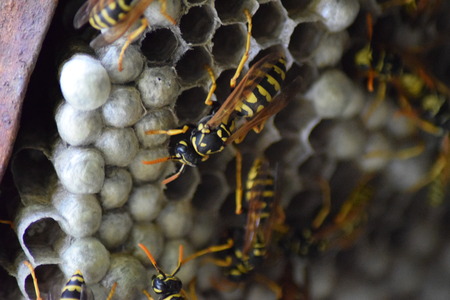Yellow Jackets vs. Honeybees
August 03, 2016
When it comes to those who harbor misgivings about honeybees, they often hold grudges due to times when they were stung by aggressive, little flying black-and-yellow insects, who are more often than not lumped under the catchall category of “bees.” However, what many don’t understand is these “bees” may not be bees at all—more specifically, they may be yellow jackets of the wasp and hornet family, which are known for their aggressive tendency to sting everyone and everything, and they are likely the culprits behind many “honeybee” attacks. Considering how important honeybees are in the growth of food we eat, it’s best to be able to recognize them before assuming they are the same “bees” that once stung you aggressively.
In terms of the difference between yellow jackets and honeybees, both insects are yellow with black markings, but yellow jackets have a brighter, shinier shade of yellow compared to less brightly colored, almost orange honeybees. Yellow jackets are hairless, have a smooth appearance, and have that famously distinctive thin, wasp-like waist, whereas honeybees are fatter and have a kind of fuzzy appearance that is often confused with bumblebees’ pale tan-yellow color.
When it comes to nesting, both insects have different preferences based on their social behavior patterns (honeybees are eusocial, serving a colony and a queen, and yellow jackets are not). Yellow jackets typically nest underground in abandoned rodent burrows while honeybees nest in cavities, such as hollowed out tree trunks or anything resembling a beekeeper’s bee box (so if you see many flying insects emerging from a hole in the ground, they're probably yellow jackets). Due to this stark difference, honeybees might stay in a nest for years while yellow jackets tend to move on after a given season or if their nest site is destroyed—which sparks a converse reaction from the insects because honeybees are mostly gentle and only give their sacrificial sting as a last resort, and yet yellow jackets will chase someone for miles to defend a nest, stinging multiple times without dying.
Moreover, a honeybee hive is less of a worry than many think, though if a hive is near or in a public place, it should be removed by a professional beekeeper for its safety and other people’s. Yellow jackets are a different story—they often should be left alone and allowed to prey on pest insects, as any ensuing cold weather usually causes nests to die off, but if the nest is in a well-traveled area, action should be taken. Hiring a professional is the best option, but some DIY options exist, such as hanging an imitation nest to act as a natural deterrent for yellow jackets and other flying pests.
Other options (in protective gear) include the yellow jackets being smothered by filling a wheelbarrow with ice, quickly dumping it over the nest, and then covering the hole with a heavy tarp weighed down with bricks other heavy objects. Then cover that with soil, wood chips, or a thick piece of clear plastic, and seal the edges tight to the ground. Some gardeners suggest pouring ten-plus gallons of boiling or soapy water into the nest. Remember, any insects that aren’t killed on contact will come after you.
Copyright: fotogigi85 / 123RF Stock Photo


.jpg)



